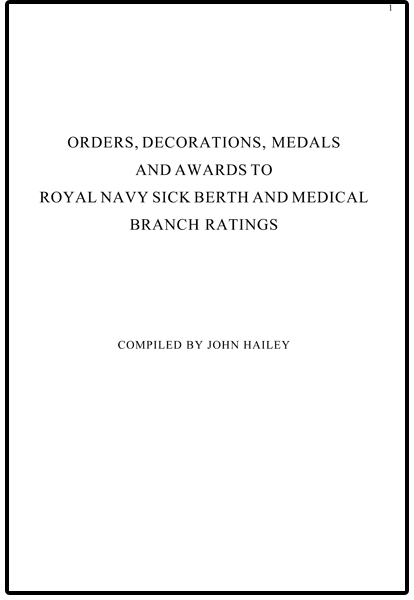Sick Berth Staff Medal Rolls
RNSB & MB Orders, Decorations & Medals
ORDERS, DECORATIONS, MEDALS & AWARDS TO ROYAL NAVY SICK BERTH AND MEDICAL BRANCH RATINGS
The first recorded use of the rating of ‘Sick Berth Attendant’ appears in an Admiralty directive of 1833, when Commanding Officers were ordered to organise such a category of naval rating in each ship. These early Sick Berth Attendants received no formal training and had to rely on knowledge and experience gained from working with ship-board surgeons. This situation soon proved to be unsatisfactory and it was obvious that a complete review of the workings of the Naval Medical Service was urgently required. The catalyst for reform was the Crimean War of 1854-5, but it was to be another thirty years before any reform took place.
In June 1883 a Committee was formed to enquire into the organisation and training of Naval Sick Berth and Nursing Staff. This Committee was known as the Hoskins Committee after its chairman Rear Admiral A. H. Hoskins. Although the committee completed its findings in late 1883, it was not until October 1884 that an Order in Council authorised the establishment of a trained Sick Berth Branch for male ratings. At the same time the female Naval Nursing Service was also established, receiving Royal patronage in 1902 and becoming the Queen Alexandra Royal Naval Nursing Service.
In 1891 the ratings of the Sick Berth Branch were given a new style of uniform. Instead of the ‘Square rig’ consisting of blue serge jumper and bell-bottom trousers they were given a jacket, ordinary trousers, white shirt, black tie and a peaked cap known as a ‘Fore and Aft’ rig. This style of uniform was issued to all ratings ‘not dressed as seamen’. Skilled tradesmen, known as ‘Artificers’ also wore this uniform, so it was only natural that a Sick Berth Attendant was nicknamed ‘Sick Berth Tiffy’.
Initially the nursing side of a probationers training only lasted three months, but this proved too short a period and it was extended to six months. This was followed by a year in a Naval Hospital to gain experience before the Sick Berth Attendant was allowed to go to sea. Sometimes when he was drafted to a small ship he was the only medically trained person on board.
Gradually the SBA was able to obtain specialist training in such areas as Operatering Theatre Technician, Radiographer and Massuer (Physiotherepist). With the political situation in Europe worsening at the beginning of the twentieth century the Royal Naval Auxilary Reserve was reformed as the Royal Naval Volunteer Reserve. Sick Berth ratings had their own branch known as the Royal Naval Auxiliary Sick Berth Reserve, which was manned by members of the St John Ambulance Brigade.
At the outbreak of the war in 1914 the Sick Berth Branch consisted of about 5,000 men, this was later increased to about 15,000 including the RNASBR. The Royal Naval Sick Berth Auxilary Reserve continued until the end of the Second World War. In 1949 it was disbanded when the Sick Berth Branch of the Royal Naval Volunteer Reserve was formed. Further changes took place in 1965 when the words ‘Sick Berth’ was dropped in favour of ‘Medical Assistants’ and ‘Medical Technicians’, also at this time the Queen Alexandra Royal Naval Nursing Service (QARNNS) was reorganised permitting men to join as Nursing Officers and Ratings.
Contents of attached PDF. Please click on the link to view.
INTRODUCTION
ABREVIATIONS
ORDERS
Royal Victorian Order
Order of the British Empire
Member
British Empire Medal
DECORATIONS
Royal Red Cross
Albert Medal
Conspicuous Gallantry Medal
George Medal
Distinguished Service Medal
Queen’s Gallantry Medal
CAMPAIGN MEDALS
Naval General Service 1793 – 1840
St Jean D’Acre 1840
China 1840 – 1842
New Zealand 1845 – 46, 1860 – 1866
India General Service 1852 – 1895
Baltic 1854 – 1855
Crimea 1854 – 1856
Turkish Crimea 1854 – 1856
China 1856 – 1860
Canada General Service 1866 – 1870
Abyssinia 1867 – 1868
Ashanti 1873 – 1874
South Africa 1877 – 1879
Egypt 1882 – 1889
Khedive’s Egyptian Star 1884 – 1891
East and West Africa 1887 – 1900
Khedives Soudan 1896 – 1908
Queen’s South Africa 1899 – 1902
China 1900
Africa General Service 1902 – 1910, 1921 – 1952
Naval General Service 1915 – 1952
MERITORIOUS, CORONATION and JUBILEE
Meritorious Service Medal
Coronation 1902
Coronation
Delhi Durbar 1911
Silver Jubilee 1935
Coronation 1937
Coronation 1953
LONG SERVICE and GOOD CONDUCT
MISCELLANEOUS AWARDS
Mentioned in Dispatches
Sick Berth Petty Officers’ Efficiency Medal
FOREIGN AWARDS
Belgium
Croix de Guerre
France
Medaille Militaire
Croix de Guerre
Chevalier of the Imperial Order of the Dragon of Annam
Italy
Messina Earthquake Medal
Netherlands
Order of the Orange Nassau
Poland
Krzyz Walecznych (Cross of Valour)
Russia
Order of St George
INDEX
